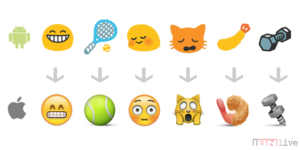
Lidya Nada via Unsplash
Emojis are undeniably fun, and sometimes they ‘speak louder than words’. They enable us to add emotional context to plain text, such as humor, brevity or irony. They illustrate non-verbal cues that could be expressed in face-to-face communication including gestures and facial expressions. However, when creating content for a multicultural audience, it’s important to consider how different cultures perceive symbols, colors, and body language.
The most popular emojis around the world
Although being an “official” emoji translator just became a thing in 2017, a study done by Swiftkey in 2015 uncovered insights to how different languages around the globe are using emoji by analyzing over one billion pieces. Here are some interesting findings:
- Americans score highest for a variety of emojis, including skulls, birthday cake, fire, tech, LGBT, meat, and female-oriented icons.
- Canada uses the smiling poop emoji more than any other country. It also leads in violent, body parts, money, sports, raunchy, and ocean creatures.
- French leads in the heart emoji, and uses hearts 4x more than any other languages. The red heart is also the #1 emoji for several Scandinavian and Eastern European countries.
- Arabic-speakers are fond of roses and flowers.
- Swedish-speakers use the bread emoji more than any other language.
- Scandinavian (Danish, Swedish, Norwegian) use the Santa emoji more than all other languages. (But… doesn’t Santa live in Finland?).
- Australia uses double the amount of alcohol-themed emoji than others, 65% more drug emoji than average, and leads for both junk food and holiday.
- Portuguese speakers actually topped Australia in the use of drug emojis (pill, syringe, mushroom, cigarette) when Swiftkey published its second report.
- Brits use the winky emoji twice the average rate.
Emojis are understood differently by different cultures
The meaning of an emoji varies greatly depending on culture, language, and generation. Using emojis in cross-cultural communications runs the risk of being misunderstood. Here are some examples of cultural variations:
 In countries like Brazil, Italy, Greece, Portugal, Colombia and Argentina, the “metal horns” can indicate that the person was cheated on by their partner.
In countries like Brazil, Italy, Greece, Portugal, Colombia and Argentina, the “metal horns” can indicate that the person was cheated on by their partner.
 While the “waving hand” is used to say hello or goodbye in one language, it can signify the ending of a friendship in another.
While the “waving hand” is used to say hello or goodbye in one language, it can signify the ending of a friendship in another.
 “Thumbs-up” may be a sign of approval in Western cultures; but it is considered an obscene gesture in Greece and the Middle East.
“Thumbs-up” may be a sign of approval in Western cultures; but it is considered an obscene gesture in Greece and the Middle East.
 In Brazil and Turkey, the “OK” hand gesture is considered as an insult, and is equivalent to giving the middle finger in America.
In Brazil and Turkey, the “OK” hand gesture is considered as an insult, and is equivalent to giving the middle finger in America.
 “Clapping hands” shows praise and offer congratulations in Western countries, while in China it’s a symbol of making love.
“Clapping hands” shows praise and offer congratulations in Western countries, while in China it’s a symbol of making love.
 The “slightly smiling” emoji is not used as a sign of happiness in all countries. In China, it implies distrust, disbelief, or someone humoring you. It can also convey an ironic tone of voice in other contexts.
The “slightly smiling” emoji is not used as a sign of happiness in all countries. In China, it implies distrust, disbelief, or someone humoring you. It can also convey an ironic tone of voice in other contexts.
 The angel emoji can imply having performed a good deed or signify innocence in the west, while it may be used as a sign of death and be perceived as threatening in China.
The angel emoji can imply having performed a good deed or signify innocence in the west, while it may be used as a sign of death and be perceived as threatening in China.
 Dreaming of an eggplant on the first night of the New Year means good fortune in Japan. Some people take the eggplant for what it is: a vegetable. In other countries like the U.S, Trinidad and Ireland it has a strong sexual connotation, especially by users ages 18 to 24.
Dreaming of an eggplant on the first night of the New Year means good fortune in Japan. Some people take the eggplant for what it is: a vegetable. In other countries like the U.S, Trinidad and Ireland it has a strong sexual connotation, especially by users ages 18 to 24.
 Similarly to the eggplant, some cultures take the peach for what it is: a fruit. Other countries translate this emoji to “butt”.
Similarly to the eggplant, some cultures take the peach for what it is: a fruit. Other countries translate this emoji to “butt”.
Tips for localizing cross-cultural content with Emojis
Given that emojis are open to interpretation, using them for a multinational audience can be tricky. However, emojis have been proven to boost engagement levels, click-through-rates, and open rates in marketing initiatives. In 2015, Oxford Dictionaries made the Face With Tears of Joy emoji the word of the year. There are many benefits of using emojis in marketing, and they are inevitably here to stay.
So, what should we consider when localizing cross-cultural content?
- Avoid using hand gesture emojis.
- Avoid using only emojis to convey any idea.
- Make the emoji relevant to the text in order to enhance the meaning.
- Consider how it looks on different platforms.

- Sometimes it might be best to spell it out *Neutral face*.
Conclusion
Just being proficient linguistically is not enough to translate emojis. Context and cultural differences need to be considered, thus full localization of the content is essential.
Are you curious about using emoji in your cross-cultural content? Contact us for a free consultation.















Recent Comments